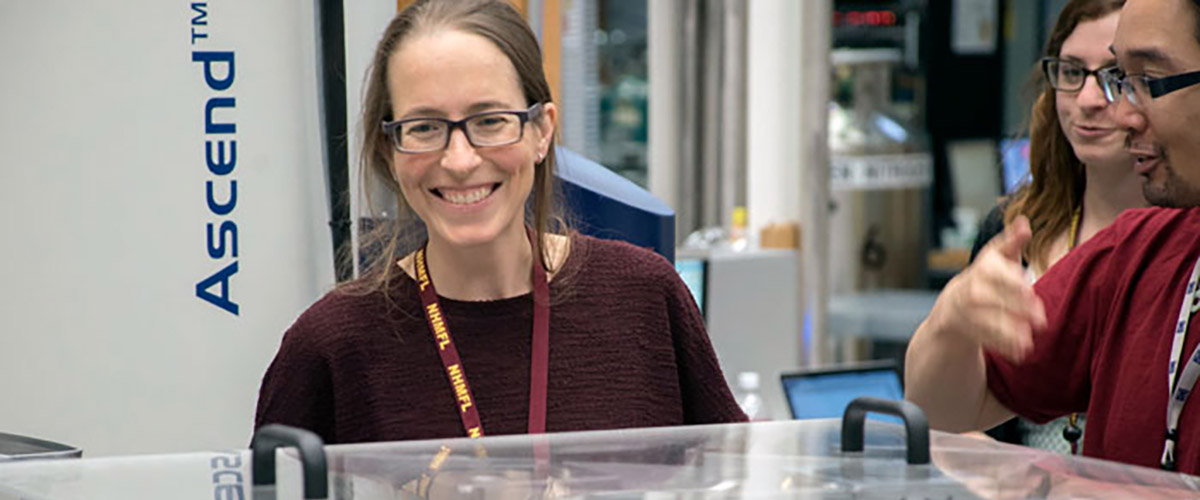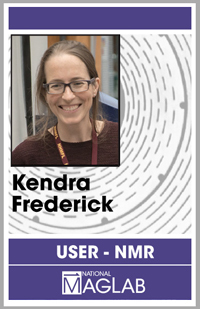
It's freaking hard to examine proteins closely in their native habitat. With the help of very clever magnet instrumentation, University of Texas scientist Kendra Frederick is up for the challenge.
Context is critical in science. Jane Goodall could not have understood primate behavior by watching one chimp in a cage. Edwin Hubble could never have surmised an expanding universe by observing a single star.

And scientists now studying proteins associated with Alzheimer's disease would miss a vital piece of the puzzle if they only looked at them outside their cellular environment.
That's why biophysicist Kendra Frederick wants to use nuclear magnetic resonance (NMR) spectroscopy to study proteins in their natural, cytoplasmic habitat.
That approach is not the norm in structural biology: researchers usually look at "purified" samples, extracting a bunch of the proteins they're interested in from cells and concentrating them in a little tube. It's a lot easier to study their structure when other material isn't in the way and there are more of them to see.
Frederick's in situ approach is much more challenging, but she's not stopping there. Making an already tough task exceptionally thorny, she wants to zero in on specific atoms in a protein's complex structure.
"I want to see if I can get the atomic resolution for a protein at its normal levels in the cellular environment," explained Frederick, an assistant professor at the University of Texas Southwestern Medical Center. "Which is both very logical and freaking ridiculous."
Frederick is petite, hyper-articulate and high-energy, boasting the kind of well-rounded smarts (she aced all her subjects in school, and once considered becoming a photographer) that most of the rest of us find a little intimidating. Nonetheless, science sometimes so awes her that she can find no better way to describe it than, "So freaking cool."
And in view of Frederick's ambitious research, it's hard to argue with her.
Frederick came to the National MagLab in May, the first external scientist to use a new magnet system that applies a technique called magic angle spinning dynamic nuclear polarization (MAS DNP) to see the structure of molecules that are otherwise nearly impossible to study with NMR. While a handful of similar systems exist, the MagLab's set up, featuring a 600 MHz magnet (14.1 tesla), is the only one in North America open to external users. (And, like all MagLab magnets, they can use it for free – as long as they share their results).
Frederick's week at the MagLab (her first, with others planned) was one step in what she half-jokingly calls a "grand plan" to develop a whole new way of doing structural biology.
"Nobody's ever done this before," pointed out Whitney Costello, a grad student in Frederick's group who accompanied her advisor to the MagLab.
As with any ground-breaking effort, there have been some kinks to work out.
Some of those kinks have to do with — well, actual kinks.
Frederick is interested in how proteins twist and turn into their distinctive shapes. As it happens, what mom said about laundry also holds true for proteins: There's a right way and a wrong way to fold. But a misfolded protein can have far worse consequences than a wrinkled blouse. Mother Nature wants that long string of amino acids to fold in a very particular way. One tiny, atomic-level misstep could mean the difference between a healthy brain and one ravaged by a neurodegenerative disease.
So how do you pinpoint one biological hiccup among all the hairpin turns of a macromolecule made up of hundreds of amino acids and thousands of atoms?
Using NMR, researchers can ascertain the atomic structure of a protein by eliciting a signal from specific isotopes within its framework. They typically have to purify proteins -- extract them from their cluttered environment so it's easier to find what they're looking for.
Frederick, though, is pushing the NMR envelope by trying to figure out what a protein looks like while it's still among and interacting with lots of other molecules, turning the experiment into an atomic-level Where's Waldo game. It's the difference between easily spotting a friend in a deserted train station at midnight, and trying to pick her out from a teeming mass of rush-hour commuters.
As if that weren't enough of a challenge, Frederick happens to be searching in a very big haystack for needles that are especially hard to see: carbon atoms. Carbon is hard to discern using NMR because it gives off a fairly weak signal. So not only is Waldo lost in a crowd, but his voice is a whisper among roars.
This is where MAS DNP comes in. Through some clever physics, the technique enhances the sensitivity of wallflower isotopes like carbon, boosting their signals. As a result, not only can researchers discern isotopes with weak signals, they can see them when they are few and far between.
"It's blinding. It's huge," said Frederick. "MAS DNP is enabling whole new types of experiments. Prior to this technology for solid state NMR, we couldn't even dream of looking at quantities this small, just because you would have to sit in a laboratory for 30 years," to accumulate enough of a signal.
When it comes to unraveling cumbersome problems like protein folding, two disciplines can be better than one. That's why Frederick worked under not one but two prominent scientists during her postdoctoral training at the Massachusetts Institute of Technology: physicist Bob Griffin and biologist Susan Lindquist. With Griffin, she learned solid state NMR, in particular MAS DNP. With Lindquist, she delved into the biological side of protein folding.
As a result, she can finesse the spectroscopy and prepare her samples well. "There are compromises you need to make between biological relevance and what you need to see, and getting the actual physics to work," said Frederick. "Right now I'm rather unique in having a window into both fields."
In fact, Frederick is quite the geek when it comes to instrumentation and machines she uses for her experiments. The magnets, the cryogenics, the gyrotron: This is where words like "freaking" start to crop up. During her visit she posted selfies with magnets on her Twitter feed. Weaving between equipment in the black, knee-high, platform boots she wears to add oomph to her frame, Frederick can't contain her nerdy joy.
"I really, tragically, love magnets," she mooned, not a hint of tragedy in her voice.
Lucky for Frederick, she did not have to face magnet withdrawal after her MagLab experiment. So critical are magnets to her research that she is now setting up her own MAS DNP system in her UT lab.
During their week in the MagLab's NMR Facility, Frederick and Costello worked on refining techniques for future MAS DNP experiments. For now working with yeast as a model system, they will switch to proteins associated with Alzheimer's and similar pathologies, after working out technical issues.
"I think the problem of protein folding in neurodegenerative disease is uniquely suited to the technique, because the environment is clearly important," said Frederick. "You have the exact same protein in two different environments. One person is genetically predisposed to get a disease, for example, and the other person is not. We have some clues and some ideas about what those risk factors are, but we don't actually, really know how this plays out on a molecular level."
When Costello was considering what research to do at UT as an incoming graduate student, she knew she'd found her place after meeting Frederick.
"I loved her passion," said Costello. "She absolutely loves what she does."
But Costello is also drawn to Frederick's research for deeply personal reasons.
"My grandma had Alzheimer's and my step-grandma had Alzheimer's. So I've kind of seen it," said Costello, who worked as a technician in a genetics lab for two years before landing at UT to study biophysics. "Watching my grandparents, I knew I wanted to do more medical-related research."
As for Frederick, finally getting her hands on the MagLab's MAS DNP system has allowed her to troubleshoot technical challenges and clear yet another hurdle in her longtime goal of viewing the atomic structure of proteins in the natural environment.
"I've been waiting to do this for so long," she said.
She is already planning for her next MagLab visit later this year.
By Kristen Coyne
Photos by Stephen Bilenky
More than 1,400 scientists come from across the world to use our unique magnets. If you have an experiment you would like to do here, find out how to request magnet time. Magnet time is free.
Last modified on 02 December 2022